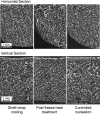Studying the morphology of lyophilized protein solids using X-ray micro-CT: effect of post-freeze annealing and controlled nucleation
- PMID: 24879291
- PMCID: PMC4179649
- DOI: 10.1208/s12249-014-0152-5
Studying the morphology of lyophilized protein solids using X-ray micro-CT: effect of post-freeze annealing and controlled nucleation
Abstract
The objective of this study was to determine how different techniques used during the freezing step of lyophilization affect morphology of the dried protein solids. Aqueous solutions containing recombinant human albumin, trehalose, and sodium phosphate buffer were dried after their freezing by shelf-ramp cooling, immersion in liquid nitrogen, or controlled ice nucleation. Some shelf-frozen solutions were heat treated (annealed) before the vacuum drying. We used three-dimensional (3D) X-ray micro-computed tomography (micro-CT) and scanning electron microscopy (SEM) to study the morphology of solids. The X-ray micro-CT images of the lyophilized microporous solids showed traces of varied size and structure ice crystals that were comparable to corresponding SEM images. A post-freeze heat treatment and a controlled nucleation both induced larger ice crystal ghosts in the solids. The variations in the structure of walls surrounding ice crystals, formed by the different freezing procedures, should affect the water vapor transition during the primary and secondary drying. Some solids also showed higher-density layer in the upper surface. Overall, the simple sample preparation procedures and the ample morphological information make the X-ray micro-CT appropriate for analyzing lyophilized pharmaceuticals.
Figures





Similar articles
-
Annealing to optimize the primary drying rate, reduce freezing-induced drying rate heterogeneity, and determine T(g)' in pharmaceutical lyophilization.J Pharm Sci. 2001 Jul;90(7):872-87. doi: 10.1002/jps.1040. J Pharm Sci. 2001. PMID: 11458336
-
Observation of glassy state relaxation during annealing of frozen sugar solutions by X-ray computed tomography.Eur J Pharm Biopharm. 2018 Jun;127:279-287. doi: 10.1016/j.ejpb.2018.02.027. Epub 2018 Mar 20. Eur J Pharm Biopharm. 2018. PMID: 29510203
-
Effects of buffer composition and processing conditions on aggregation of bovine IgG during freeze-drying.J Pharm Sci. 1999 Dec;88(12):1354-61. doi: 10.1021/js980383n. J Pharm Sci. 1999. PMID: 10585234
-
Fundamentals of freeze-drying.Pharm Biotechnol. 2002;14:281-360. doi: 10.1007/978-1-4615-0549-5_6. Pharm Biotechnol. 2002. PMID: 12189727 Review.
-
Protein purification process engineering. Freeze drying: A practical overview.Bioprocess Technol. 1994;18:317-67. Bioprocess Technol. 1994. PMID: 7764173 Review.
Cited by
-
Impact of Excipients on Stability of Polymer Microparticles for Autoimmune Therapy.Front Bioeng Biotechnol. 2021 Feb 11;8:609577. doi: 10.3389/fbioe.2020.609577. eCollection 2020. Front Bioeng Biotechnol. 2021. PMID: 33644005 Free PMC article.
-
In-Situ X-ray Imaging Of Sublimating Spin-Frozen Solutions.Materials (Basel). 2020 Jul 1;13(13):2953. doi: 10.3390/ma13132953. Materials (Basel). 2020. PMID: 32630310 Free PMC article.
-
Wurster Technology-Assisted Step-by-Step Engineering of Multi-layered Pellets (Sprinkles): Microscopy, Micro-CT, and e-Tongue-Based Analysis.AAPS PharmSciTech. 2024 Feb 29;25(3):50. doi: 10.1208/s12249-024-02773-2. AAPS PharmSciTech. 2024. PMID: 38424241
-
Freeze-Drying as a Tool for Preparing Porous Materials: From Proof of Concept to Recent Pharmaceutical Applications.AAPS PharmSciTech. 2025 Jun 3;26(5):159. doi: 10.1208/s12249-025-03117-4. AAPS PharmSciTech. 2025. PMID: 40461910 Review.
-
Comparative Evaluation of Pellet Cushioning Agents by Various Imaging Techniques and Dissolution Studies.AAPS PharmSciTech. 2020 Dec 29;22(1):14. doi: 10.1208/s12249-020-01902-x. AAPS PharmSciTech. 2020. PMID: 33377174 Free PMC article.
References
Publication types
MeSH terms
Substances
LinkOut - more resources
Full Text Sources
Other Literature Sources

